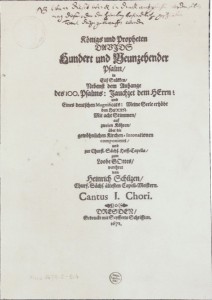Schütz’s Opus Ultimum: Der Schwanengesang
Acknowledged by his contemporaries as the greatest German composer of the seventeenth century, Heinrich Schütz served for over fifty years as Kapellmeister of the Court Chapel of the Elector of Saxony in Dresden. He was instrumental in introducing the modern Italian styles of composition into Germany during the first half of the century. Over the course of his life Schütz wrote in a wide variety of genres, including the first German opera, settings of the Passions and several collections of sacred chamber music for voices and instruments.
Studying with Giovanni Gabrieli in Venice as a young man left an indelible mark on Schütz, and nowhere is his debt to the Venetian polychoral tradition more evident than in his Opus Ultimum, known as Der Schwanengesang (Swan Song.) There is a satisfying sense of completion in Schütz’s decision, for his final work, to return to the style so strongly associated with his beloved mentor. Like Bach in his Art of the Fugue, Schütz seems to have chosen an exhaustive exploration of a clearly circumscribed genre as his legacy.
Der Schwanengesang is actually a setting of three separate texts. The first eleven parts, or motets, set Psalm 119, by far the longest of the psalms, totaling 176 verses. Like several other Old Testament texts, including the Lamentations of Jeremiah, Psalm 119 is an “acrostic” poem. The entire psalm is divided into twenty-two stanzas of eight verses each, with all the verses in a stanza beginning with the same Hebrew letter. Schütz pairs the stanzas into eleven sixteen-verse motets. To these he appends a setting of Psalm 100 and the Magnificat Canticle. All the motets conclude with a doxology, making them suitable for liturgical use, although the work doesn’t seem to have been composed with any such use in mind.
There appears to be no specific occasion or commission that prompted Schütz to compose Der Schwanengesang. Rather Schütz seems to have devoted himself to a setting of Psalm 119 as part of a deep spiritual study in the last years of his life, following the example of numerous Lutheran theologians. In his Preface to the Psalter, Martin Luther himself refers to Psalm 119 as “a small Bible wherein everything is stated most beautifully and concisely, making them as it were an elegant enchiridion or handbook within the Bible as a whole.” Similarly Johannes Bugenhagen in writing about Psalm 119 asserts, “the contents of the entire Holy Writ are contained in this one psalm.” Musicologist Wolfgang Steude (whose reconstruction of the missing second soprano and tenor parts we will be performing) suggests that Schütz chose Psalm 119 for his “swan song” knowing that “in a sense it encompasses both Old and New Testaments – the whole Bible. In so doing, he created a landmark work and a personal, spiritual, religious, and artistic testament in what was avowedly to be his final opus.”
It is unlikely that the first eleven motets were ever performed before the twentieth century. At the time of its completion in the 1670s, Der Schwanengesang must have seemed very archaic indeed, completely out of step with the Neapolitan operatic style then in favor in Dresden.
Though Schütz had title pages printed, the work as a whole was never published and was assumed lost when the first complete works edition was published in the 19th century. In 1900 six of the eight manuscript partbooks were discovered in the town of Guben. The second soprano tenor partbooks, along with the continuo part, had been previously separated. The organ part was acquired from an antiquarian bookstore in Guben and was later purchased by the writer Stephan Zweig. The vocal partbooks were held in a library in Berlin and assumed lost in 1945 but were discovered in 1970 in a collection of uncatalogued manuscripts in the Sächsische Landesbibliothek in Dresden. With this discovery, together with the organ part, now housed in the British Museum, an edition was completed in time for the 400th anniversary of Schütz’s birth in 1985.
Der Schwanengesang is set for double choir with continuo, and such a performance is entirely adequate. In his dedicatory comments to the Elector of Saxony, Schütz even recommends such a performance “by eight good voices with two little organs in the two fine choir lofts that were constructed opposite each other on either side of the altar in your Highness’ Court Chapel” However, Schütz also asked his colleague at the Dresden Chapel, Constantin Christian Dedekind, to expand his work by adding instruments. It seems that Dedekind, rather than carrying out the master’s request, made his own setting of Psalm 119, which he published several years later.
For these performances, I have assumed the task of carrying out Schütz’s request. For guidance, I turned to the extensive writings of Schütz’s predecessor as Dresden Kapellmeister, Michael Praetorius and to the many polychoral compositions of Schütz himself, as well as those of his colleagues Samuel Scheidt and Johann Hermann Schein. For this project I am deeply grateful to the advice and encouragement of Jeffrey Kurtzman, Herb Myers, Wolfgang von Kessinger and Nika Korniyenko.
